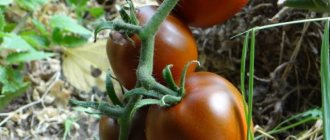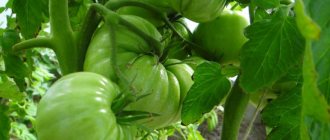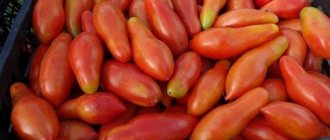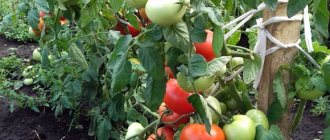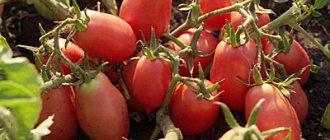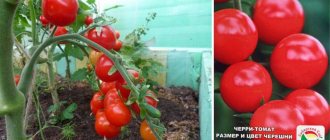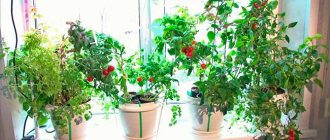General form
The Royal Mantle tomato is recommended by the manufacturer for cultivation in the Siberian regions, the Caucasus, and also in central Russia. A representative of the variety looks like this:
- The bush does not stop growing on its own, that is, it is indeterminate. Under suitable conditions, the tomato reaches a height of 1.8 m.
- The number of leaves on the shoots is average. The plates are covered with small villi and wrinkled.
- The flowers are simple. Inflorescences appear starting from 6-7 nodes. More than 5 ovaries are formed on each brush.
- The tomato bears large fruits weighing 300-500 g.
- The shape of the tomato is oval, flattened on top.
- When ripe, the fruits turn crimson. A green spot remains on the stalk.
According to ripening time | By type of growth | By type of use | By growing method | Fruit weight (g) | Yield (kg/m²) | Fruit characteristics |
| Mid-ripe (100-110 days) | Indeterminate (in a greenhouse 180 cm; in a vegetable garden 150 m) | Universal | For greenhouses and open ground | 300-500 | Up to 20 in a greenhouse; up to 15 in an open garden | Oval, crimson, fleshy |
Attention! A distinctive feature of the variety is the formation of tomatoes of the same size and shape on the cluster.
Advantages of tomato fruits
The characteristics of the fruits of the Royal Mantle coincide with the characteristics of BIF tomatoes. Large and fleshy fruits contain few seeds. The shape of tomatoes is round, flattened, with ribs at the stalk.
The fruit shell is strong, but not thick. If there is excess rainfall, tomatoes may crack during ripening. The base of the tomato is greenish even when ripe, reminiscent of the collar of the robe worn by a king.
The flesh is a rich pinkish-red color, with a good structure, reminiscent of the consistency of a melon. The taste of tomatoes is sweet with a slight sourness if they ripen on the vine. With excess moisture and lack of solar heat, it changes to classic tomato (sweet and sour).
The purpose of tomatoes is salad, the variety is suitable for fresh consumption and processing into juice or sauces. The pulp makes good slices for sandwiches; large slices can decorate slicing. Tomato slices look picturesque in a summer salad.
The juice from fleshy tomatoes practically does not need to be boiled. It will turn out thick and beautiful without it. When boiled, lecho and ketchup with various additives are prepared from the juice. Small, unripe tomatoes can also be used for canned salads.
Advantages and disadvantages
Thanks to many positive characteristics, the tomato is gaining more and more fans.
- The variety is endowed with low sensitivity to temperature changes.
- Tomato is disease resistant.
- Tomatoes are able to ripen after being picked from the bush.
- The variety is characterized by high productivity. During the season, up to 5 kg are collected from the bush.
- Tomato is not too demanding on lighting.
- The taste of the fruit is well balanced with a pleasant acidity.
Disadvantages include the inability for long-term storage and poor transportability.
Growing large-fruited tomato varieties
Many tomato lovers gardeners prefer large-fruited, salad varieties . The best of these tomatoes not only have a great taste, but their beauty will add bright colors to any feast. It’s especially nice when these fruits are grown with your own hands.
The choice of large-fruited varieties is now simply huge. Based on my experience, I can recommend the largest and tastiest, in my opinion.
(Click on the photo to see a close-up view of the variety)
Large-fruited tomato varieties with green fruits: Malachite Box, German Green Aunt Ruby
I grew individual fruits of some of the listed varieties weighing up to 1 kilogram, and the average yield per bush was in the range of 5-7 kg.
Agricultural technology for large-fruited tomatoes has its own nuances
First of all, you should pay attention to the stage of growing seedlings. If the seedlings do not receive enough light and nutrition, then you cannot expect a good harvest from them. Therefore, when growing seedlings at home, it is advisable to use additional lighting with lamps with phytolamps. It is also advisable to periodically fertilize.
This can be either root feeding (if you do not have sufficiently nutritious soil for seedlings) or foliar feeding on the leaves. For off-horse feeding, you need to very carefully select the concentration of fertilizers, since in case of an overdose, the tender leaves of the seedlings can get burned. For foliar feeding, I recommend using: Aquarin, Fertika Lux, Kristalon or Plantafol.
After planting the seedlings in the beds, fertilizing should also continue. For better fruit set, it is good to spray tomato leaves with a solution of boric acid: 1 gram per 1 liter (1 teaspoon per 5 liters of water). Root feeding with ash infusion also gives good results.
Since we expect to get a good harvest, it is necessary to properly tie the tomato stems . Due to the dense planting of tomatoes, I prefer to grow all my tomato bushes into one stem. For gartering I use a rope (like a clothesline from household goods) 4-5 mm thick. It's better when it stretches a little.
a wire peg with a hook at the end into the ground next to the tomato bush (similar to pegs for attaching a camping tent). I tie one end of the rope to a peg, and attach the other to a rail running under the roof of the greenhouse. I wrap the tomato stem around the rope, but so that it does not cut into it (one turn per 1-2 internodes).
I usually don’t tie up the brushes, since I have several hundred bushes and don’t have time for that.
In order for the fruits to fill well, they need a lot of moisture. In greenhouses I use drip tapes for watering. I connect them through a filter to the country water supply.
The water in it can be cold, but since the water flows out of the tape quite slowly, it has time to heat up before it gets to the roots, and I did not notice any oppression of the bushes.
By the time the fruit begins to ripen, watering should be made less abundant, since some varieties of tomatoes have a tendency to crack the fruit when there is excess moisture .
To spend less time on weeding, I try to mulch the beds with mowed grass . This not only protects the plantings from weeds, but also allows the soil to better retain moisture.
For diseases, I regularly carry out preventive spraying. Every week I alternately use an iodine solution (10 drops per liter), Fitoverm or a solution of potassium permanganate (2 mg per 5 liters).
The best disease prevention, in my opinion, is to protect tomato leaves from moisture. Therefore, I prefer to grow tomatoes in greenhouses.
In the summer, to avoid dew on the leaves, I always keep the greenhouses open so that they are well ventilated.
As the tomato bushes grow, I gradually remove the lower leaves (2-3 leaves per week) to better ventilate the bushes.
My tomato fruiting usually continues until the second ten days of October , while in many neighbors late blight destroys the plantings already at the end of August.
Tomato collector from the Moscow region Ilya Korolev (Royal Garden online store)
Read on topic:
Source: //tomatomania.ru/vyrashhivanie-krupnoplodnyx-sortov-tomatov/
Features of cultivation
Proper agricultural technology helps to grow tomatoes with excellent taste. In order not to be disappointed in your choice, you should follow certain rules. 2 months before the planned transplantation, seeds are sown in the ground for seedlings. To develop, seedlings require a temperature of 23-25 °C.
After the onset of heat, the tomato is planted in open beds or in greenhouses. No more than 3 bushes are placed per 1 m². Throughout the growing season, the bush is pruned. Form into 2 stems. A week after replanting, the shoots begin to be tied up. For this purpose, trellises or high supports of another type are installed in advance.
To achieve good yield, 5 brushes are left on each stem. At the end of summer, the top is pinched off. At the same time, the tomato stops growth and puts all its energy into the fruit.
Large tomatoes and greenhouse
Over time, I learned to make my work easier when growing such tomatoes (after all, I have almost 40 years of experience as a gardener), and I even neglect some things, violating traditional agricultural practices.
But believe me, the harvests were never damaged. I sow seeds for seedlings at the same time as low-growing early ripening plants, as a rule, in the first half of March (I’m not particularly keen on the lunar calendar, since the sowing time approximately coincides anyway).
I plant it in any suitable box. I separate each variety with a splinter and glue a piece of plaster with its name on the side of the box.
For picking, I use homemade pots from white bottles in which fermented milk products are sold. It is much more pleasant to work with such containers than with ordinary “one and a half containers” made from water or kvass, because the material is softer and more manageable.
Using a hot nail, I make a couple of holes in the bottom, and again I glue a patch with the name of the variety on the side. Having filled the resulting pots with soil, I place them in plastic fruit boxes.
I pick only the strongest seedlings and immediately take them out to the glassed-in loggia, where there is enough sunlight, and leave the door to the room open to add a little warmth. I don't use anything else to warm it up. And the seedlings turn out strong and healthy.
I recommend spraying the plants against diseases and feeding them during the “seedling period.”
I prepare soil for seedlings in the fall from my garden: I add rotted manure or humus, purchased soil at a ratio of 3:1:1, a little ash and river sand. I want to make a reservation right away - I don’t trust the soil that’s sold in gardening stores at all, since it’s all peat.
When transplanting into open ground, I try to maintain a distance of about half a meter between plants. In each hole I put a full shovel of manure, a handful of ash, sometimes I add a pinch of superphosphate, fill everything with water and mix.
And it turns out, as they said in the old days: if you put him in the dirt, he will grow up to be a prince. After planting I do not water for 7-10 days. I do the following watering regularly - once a week, generously and at the root.
If the leaves remain pale, I feed them with mullein infusion: 1 liter per bucket of water.
In the greenhouse, I grow large-fruited varieties on trellises: I stretch wire along the walls at a height of about 1.5 m directly above the plants.
I attach twine to it for garter and lower it to each root. On the twine I make loops every 20 cm (I tie them in advance when I print the skein).
I tie plants to them as they grow. To do this, I use old socks, cut into ribbons - that’s what high-quality knitwear means, even in a greenhouse it’s a pleasure to deal with!
I grow large-fruited tall tomatoes with one or two stems, no more, and remove all other shoots. In many varieties, the main stem doubles at a certain height, and this will be the second stem. Then both stems will begin to separate again, but in this case I leave only the one on which the flower cluster has already been outlined. If doubling of the stem does not occur, then I leave the stepson, which emerges under the first peduncle.
At the beginning of August, I stop the growth of the bushes by pinching their tops.
In practice, it happened that the second stem, not tied up in time, sank to the ground and grew. Then I did not tear it off the ground, but tied it to an additional cord, and it also gave a full harvest. This is a reserve for additional harvest and saving greenhouse space.
Reviews from summer residents
- Ninel from Tambov. I have been growing tomatoes for several years. The culture is heat-loving, so a greenhouse was specially built. I saw the described tomato in a photo online. I also read information about him there. I ordered seeds and grew seedlings. In the first season, the variety surprised me with the size of its fruits. The weight of some reached 700 g. We had to tie up not only the stems, but also the tomatoes themselves. I really liked the taste.
- Maria from Voronezh. I planted a tomato without shelter in the garden. I tied it to a high support, formed it into 2 stems, and pinched it. A couple of times a season I treated it with antifungal drugs for prevention. The tomatoes were a great success. Large, fleshy. It was enough to eat fresh and prepare juice and pasta for the winter.
- Dmitry from Tula. This is not the first year I have been planting the presented tomato. Every season the variety bears many delicious fruits, regardless of the temperature. In May, I left for a couple of days, but forgot to close the window in the greenhouse. Most of the tomatoes have shed their ovaries, but this one doesn’t matter.
Royal Mantle is a variety worthy of a loud name. Under any circumstances, the tomato will bring an excellent harvest and will delight you with its taste.
Tomato Magnus: characteristics and description of the variety
When planning to grow a Magnus tomato, you should study the description of the variety: not only the main characteristics of the plant, but also the ideal timing of sowing seeds, moving seedlings to a greenhouse or beds, watering schedule and optimal composition of fertilizing. If you strictly follow the instructions, you can achieve a good harvest and smooth ripening of the fruit.
When planning to grow Magnus tomato, you should study the description of the variety
Characteristics of tomatoes
Magnus is a promising and high-yielding hybrid of the first generation, bred by Dutch breeders. The tomato combines early ripening with good yield and high taste of the fruit.
Typically, tomatoes with a short growing season do not have very high consumer qualities, but this variety is a clear exception to the rule. Ripe tomatoes are distinguished by their attractive appearance, delicate but bright aroma, balanced taste without wateriness and herbal notes.
All these advantages make the plant an ideal option for growing in personal backyards and on small farms.
The hybrid is zoned for the Central region of Russia, but can be grown in any area. Plants feel best in film, polycarbonate or glazed greenhouses. The shortened growing season makes it possible to plant tomatoes in mid-spring; the harvest can be harvested in the first half of summer.
In regions with a warm climate, you can try to grow seedlings in open beds, but in this case the yield is slightly reduced.
Magnus is a promising and high-yielding hybrid of the first generation, bred by Dutch breeders
Magnus has good resistance to diseases and pests. The hybrid is rarely affected by cladosporiosis, verticillium, and root-knot nematodes. Cases of virus infection are rare. Early ripening protects seedlings from late blight of fruits and leaves.
Also read: Tomato Khorovod: characteristics and description, reviews from farmers
Description of the plant
The hybrid is an early ripening hybrid; 95 days pass from the emergence of seedlings to the harvesting of the first fruits . The bush is semi-determinate, moderately spreading, the formation of green mass is average. The leaves are large, dark green, the stems are strong, juicy, and not prone to brittleness.
Light shaping is necessary with the removal of excess shoots, but heavy pruning will not benefit the plant. The inflorescence is simple. The tomatoes ripen in beautiful small clusters of 4-6 pieces; at the moment of active fruiting, the bush looks very decorative.
Fruits can be picked in clusters or individually, in a state of physical or technical ripeness.
The tomatoes are flat-rounded, with pronounced ribbing at the stalk. The color is deep red, without spots or stripes. The skin is thin, but quite dense and glossy. The fruits are smooth, medium-sized, but very beautiful.
The average weight ranges from 140 to 160 g. In appearance, Magnus resembles a Matias F1 or Eigen F1 tomato, but the latter is more impressive in size (average fruit weight is from 180 to 200 g).
The pulp is juicy, has few seeds, and the chambers are small.
Such tomatoes can be used for whole-fruit canning or included in assorted vegetables. The rich, bright taste makes tomatoes suitable for making soups, sauces, purees for baby food, and bright red thick juices.
Magnus is best propagated by seedlings
The hybrid has excellent taste. The pulp contains a lot of sugars, solids, lycopene, vitamin C and amino acids. The tomatoes are aromatic, sweetish, with light fruity notes. Close analogues in taste are tomato Schastie Russkoe F1, Berberana, Belfort, Gilgal, Eigen F1, Mondial, Sovereign. Gardeners who have already tried these hybrids will certainly like Magnus.
Its big advantage is its early ripening. The listed plants begin to bear fruit 10-15 days later. Another interesting analogue is the pink-fruited tomato Lily Marlene F1, which is often grown in the same greenhouse with Magnus due to similar agrotechnical requirements.
Also read: Tomato variety Roma: characteristics and description
Advantages and disadvantages
The advantages of the Magnus F1 hybrid include:
- high productivity;
- early amicable maturation;
- excellent taste of ripe tomatoes;
- low maintenance requirements;
- resistance to cladosporiosis, verticillium, root-knot nematode;
- the ability to grow in any shelter - from ordinary greenhouses to heated greenhouses;
- versatility of fruits;
- availability of seed material.
Experienced gardeners highly appreciate the consumer qualities of the hybrid. Magnus F1 cannot be classified as a new product; it has been successfully grown for several years. Reviews from professionals and amateurs note stable yields, good taste of ripe tomatoes, and resistance to pests and diseases. A close analogue is the Indio F1 tomato; these plants can be grown in the same greenhouse.
Magnus tomatoes have few disadvantages. They are picky about the composition of the soil and love generous fertilizing and proper watering. Under favorable conditions, productivity increases significantly. In the first generation, hybrids can produce seeds, but the resulting seedlings do not carry the qualities of the mother plants.
Subtleties of cultivation
Magnus is best propagated by seedlings . When planted directly in the ground, tomato seeds will germinate too late, which will significantly reduce the yield.
Depending on the region, sowing begins in late February or early March. Picking can slow down the growth of seedlings.
Young tomatoes must be fed with liquid complex fertilizer, since the hybrid prefers nutritious soil.
Magnus tomatoes have few disadvantages. They are picky about the soil composition and love generous fertilizing and proper watering.
The seedlings are moved to the shelter in early or mid-May. A good neighbor in the greenhouse will be the Bagheera F1 tomato, which is also an early ripening tomato. The plants are tied to supports, and the lower leaves are removed for better insolation.
It is possible to form 2-3 stems, the remaining stepsons should be removed. Gardeners who want to extend the harvest period can supplement Magnus with the later Belle F1 tomato.
The tomato duet will allow you to harvest until the end of summer.
A promising hybrid of Dutch selection suitable for most subsidiary plots. By planting Magnus in a greenhouse or in garden beds, you can count on a decent harvest and wonderful taste of ripe tomatoes.
Also read: Fattening tomatoes in a greenhouse: reasons and methods of control
(2 4,50 of 5) Loading...
Source: //sadovodu.com/2017/03/tomat-magnus-xarakteristika-i-opisanie
